Bridlington, East Riding of Yorkshire
Up to 1834
Bridlington's established its first workhouse in around 1728. A workhouse on Church Green dates back to at least 1743.
Low Hall, on Sands Lane in Hunmanby, was originally the local manor house, dating back to the sixteenth century. It became the parish workhouse in 1785. The establishment was also used by many other parishes in the area including Bessingby, Buckton, Burton Fleming, Butterwick, Filey, Firby, Flamborough, Folkton, Fordon, Foxholes, Gransmoor, Muston, Osgodby, Reighton, Rudston, Shipsea, and Speeton. Hunmanby became the centre of a Gilbert Union which in 1830 comprised ten parishes (Mitchelson, 1953).
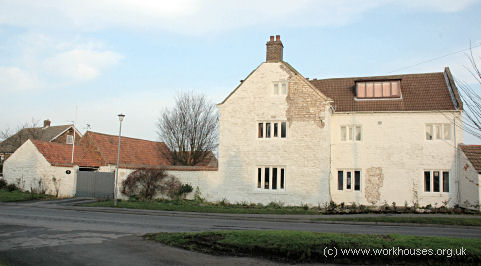
Hunmanby former parish workhouse, 2006.
© Peter Higginbotham.
After 1834
Bridlington Poor Law Union was formed on 28th October 1836. Its operation was overseen by an elected Board of Guardians, 34 in number, representing its 32 constituent parishes and townships as listed below (figures in brackets indicate numbers of Guardians if more than one):
East Riding: Argam, Auburn, Barmston, Bempton, Bessingby, Boynton, Bridlington & Quay (3), Buckton, North Burton [Burton Fleming], Burton Agnes, Carnaby, Dringhoe Upton & Brough, Easton, Flamborough, Fordon, Fraisthorp, Gransmoor, Grindale, Haisthorpe, Hilderthorp, Hunmanby, Lissett, Rudston, Reighton, Sewerby and Marton, Skipsea, Speeton, Thwing, Thornholm, Ulrome, Willsthorp, Wold Newton.
The population falling within the union at the 1831 census had been 11,924 — ranging from Willsthorp (population 12) to Bridlington itself (4,792). The average annual poor-rate expenditure for the period 1834-6 had been £3,782.
Initially, the Bridlington Guardians declined to build a new workhouse but made use of the existing Church Green workhouse in Bridlington. However, in 1846, a new building for 150 inmates was erected on the south side of Marton Road, at a cost of about £6,000. The site location and layout are shown below.
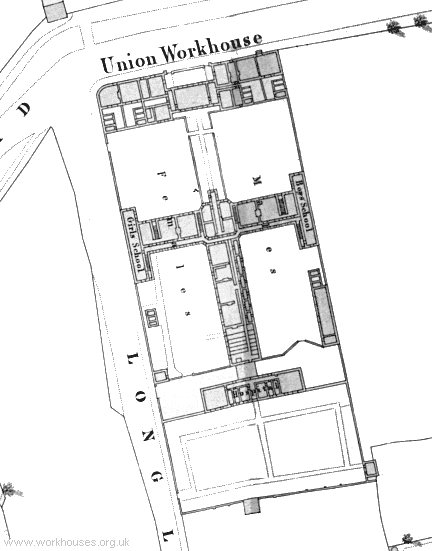
Bridlington Marton Road workhouse site, 1850.
Two single-storey entrance blocks lay at the north of the site.
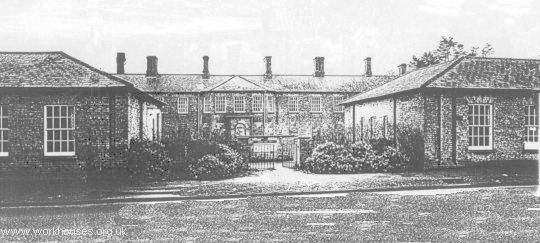
Bridlington entrance from the north, c.1910.
© Peter Higginbotham.
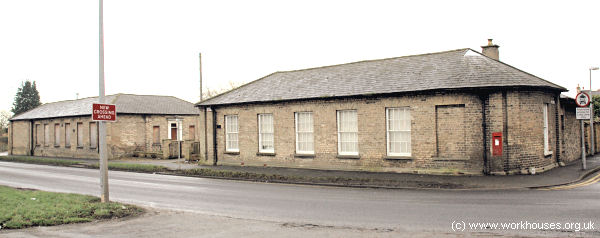
Bridlington entrance block from the north-west, 2006.
© Peter Higginbotham.
The main block was T-shaped with females accommodated at west and males at the east. Boys' and girls' accommodation and school rooms were placed at the far end of their respective wings.
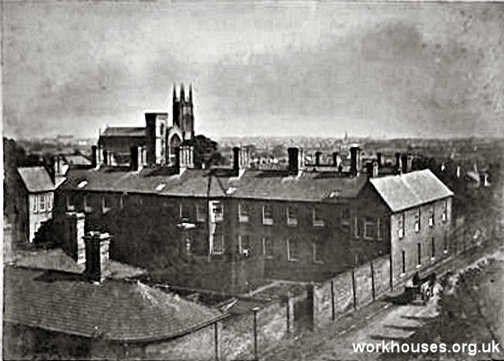
Bridlington workhouse block from the north-west.
An infirmary block stood at the south of the site.
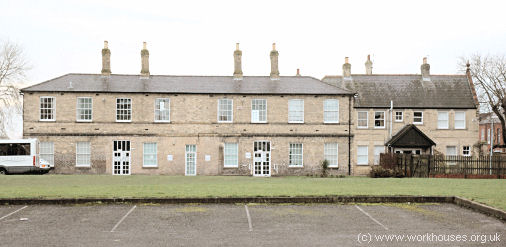
Bridlington infirmary block from the north, 2006.
© Peter Higginbotham.
Later expansion included additional blocks at the outer sides of the male and female yards, and additional hospital block and mortuary at the south-east of the site, and a Guardians' board-room at the south-west.
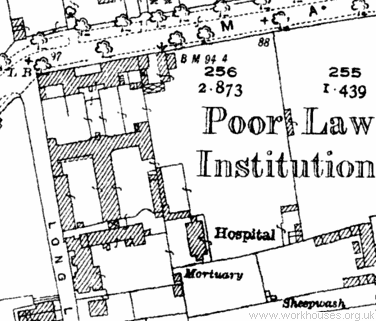
Bridlington Marton Road workhouse site, 1928.
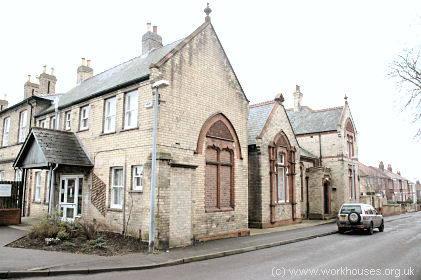
Bridlington infirmary and boardroom from the north-west, 2006.
© Peter Higginbotham.
After 1930, the workhouse was taken by the East Riding County Council and redesignated as a Public Assistance Institution. The buildings were improved with stone-flagged floors being replaced and electricity installed. The site was renamed Burlington House and continued to provide geriatric accommodation.
Children's Home
In June 1920, the union formally opened a children's home at 29 High Street. After being taken over by the county council in 1930, the home was named Hoggard House, perhaps after one of the former union's guardians, Mr W. Hogagrd.
In the early 1940s, Kenric Russel-Jones became a resident of the former workhouse, later moving on to various Council children's homes. He recalls:
Lately, due to my mother's death recently (aged 93), I've learnt she had a habit of dumping her 6 children into 'care' beginning with my oldest brother just prior to my birth in 1940, he was days from his third birthday. Father was away in the RAF so she, my mother, could dispose as she wished. The War took my father to the East Riding of Yorkshire, we followed sometime latter. This was the beginning of the end for the family with my father becoming ill with a brain tumour and being discharged from the RAF. Because he could not find work, this and the general lack of work in the area, caused great problems.
My elder brother tells me we kids starved and would beg or steal food in order to eat. Things were so bad that we would search people's dustbins for scraps to eat or visit the rear of a greengrocer's to hunt for discarded fruit or vegetables. Time was against us and so eventually the older four siblings were taken into that thing Society called 'Care'. I grew up not remembering I had a younger brother and sister until I was thirteen or so.
I went into the Workhouse, in the nursery section, where I was the eldest child. My brother, unknown to me, was also in the Workhouse. Where my second brother and sister were placed is also unknown. Eventually, we four kids were placed in the Children's Homes, sometimes together but more usually separated for long periods until we lost any family bonds that we might have had.
The Homes in the East Riding employed staff well practised in the various forms of mental, physical, and sexual abuse. Occasionally we were looked after by kind, decent people, for example Matron Baker of Cardigan Road Children's Home, Bridlington, and Miss Williams of Ravenswood CH in Hornsea, to these two kind souls I was someone, an individual, a child who needed some form of human kindness and care. I shall never forget them. Nor shall I forget the horrors I was forced to endure through the rest of my life for what followed after leaving Ravenswood CH for a certain Boys Home in Hull would be far, far worse, resulting in a nightmare which has remained with me to this day. And all this started from being a Workhouse kid after leaving the sanctuary of that Workhouse!
I wonder, who will write the history of the Children's Homes, who will give just praise for the few who cared for their charges, who will expose the horrors of those who suffered in the hands of their so called guardians. And who really cared? Society? I think not!
© 2006, Kenric Russel-Jones
Staff
Inmates
Records
Note: many repositories impose a closure period of up to 100 years for records identifying individuals. Before travelling a long distance, always check that the records you want to consult will be available.
- East Riding of Yorkshire Archives and Local Studies, The Treasure House, Champney Road, Beverley HU17 9BA . Holdings include: Guardians' minute books (1836-1930); Ledgers (1836-1930); Visiting committee minutes (1896-1908); etc.
Bibliography
- Bridlington and Driffield Workhouses by Anthony Chadwick (Ripon Museum Trust leaflet, 1996)
- Mitchelson, N (1953) The Old Poor Law in East Yorkshire (East Yorkshire Local History Society - Pamphlet No.2).
Links
Thanks
- Thanks to Kenric Rusel-Jones, now sadly deceased, for kindly allowing his recollections to be included.
Unless otherwise indicated, this page () is copyright Peter Higginbotham. Contents may not be reproduced without permission.


